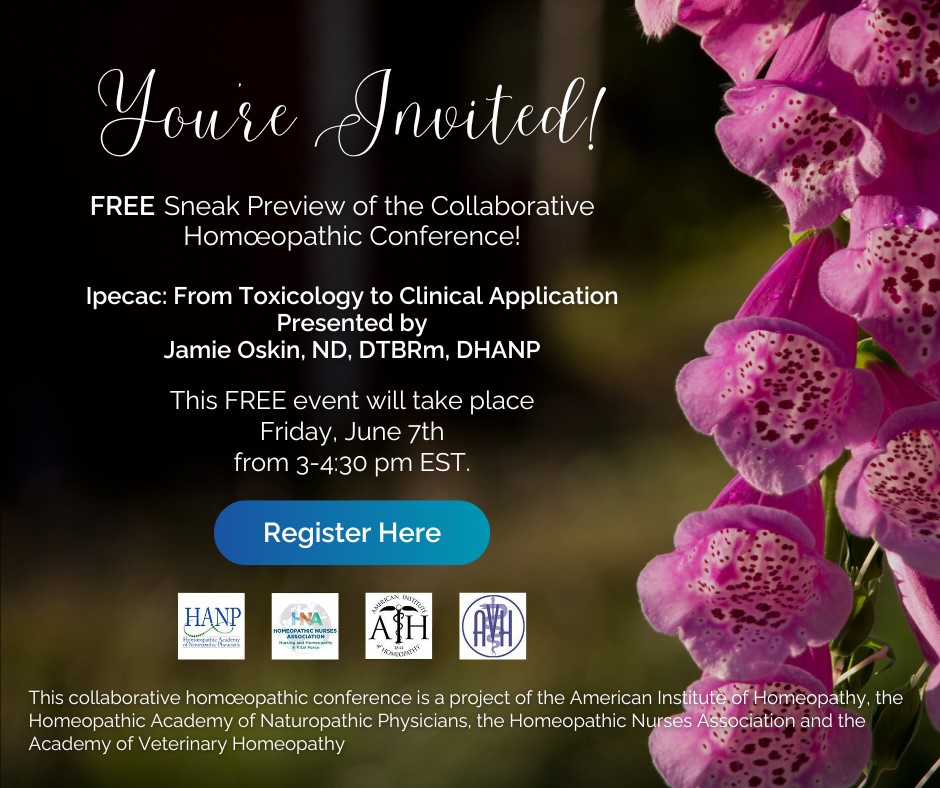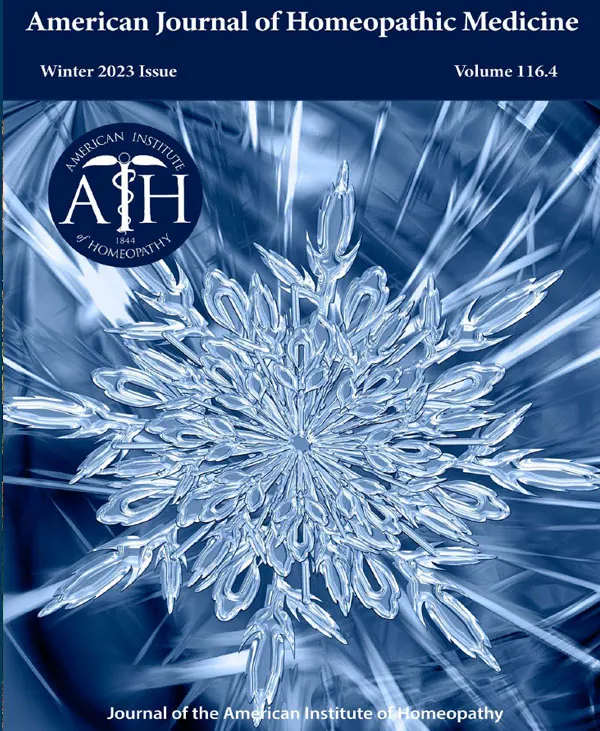
Groundbreaking Science: Homeopathy and the Future of Global Health Conference Report
Sponsored by AIH, GIRI, and the Faculty of Homeopathy (UK)
UConn Health, Farmington CT October 20-22, 2023
Reviewed by Richard Moskowitz, MD, DABHM
I’m a clinician, not a research scientist, and the nuts and bolts of the basic research presented at this conference were too far over my head for me to discuss them critically or judge their accuracy. I came to it mainly to show my face and hopefully renew old friendships after what felt like a long and dreary quarantine. For both reasons, I was both surprised and delighted by many of the presentations, even and especially when I got lost in important minutiae, like whether or not the controls were really placebos, a dilemma that led to potentizing the water as well as the substances diluted in it. Mixed in with these were exciting and inspiring moments when I felt a growing sense of a reality here and now that I’d always consigned to the future, that our oddball homeopathy is in fact a science, and has already begun to break down the barriers and spill over the boundaries that have so long kept us so far beyond the pale of medicine, science, and society at large.
A modest example was the simple gratitude I felt at the willingness of UConn Health, the vast medical school in Farmington, Connecticut, to host the event and encourage a respectable cohort of its students and faculty to attend it. Even more impressive was the total of 500+ attendees, from 25 different countries, who paid and showed up, both in person and virtually, far beyond the audiences we’ve come to expect. The conference was recorded for those who would like to watch it.
Like the frosting on that cake, Prof. Sydney Everhart, the head of Plant Science and Landscape Architecture at UConn, blessed the proceedings with a lecture of her own, and even sat on a panel with homeopaths from Brazil, Iran, and the UK, speculating on how ultradilute substances might increase crop yields. As far as I can remember, the H word never once appeared in her lecture, but she was overheard telling several colleagues that she was excited about homeopathy, wished she’d known about it before, and fully intended putting it to work in the future. A similarly nonsectarian language had likewise been adopted by a major co-sponsor of the event, the International Group for Research into the Infinitesimal, or GIRI, which supplied many of the speakers, most of whom were trained in homeopathy, but wanted to be known for the real scientific issues it poses, free of the mindless controversy attached to its name.
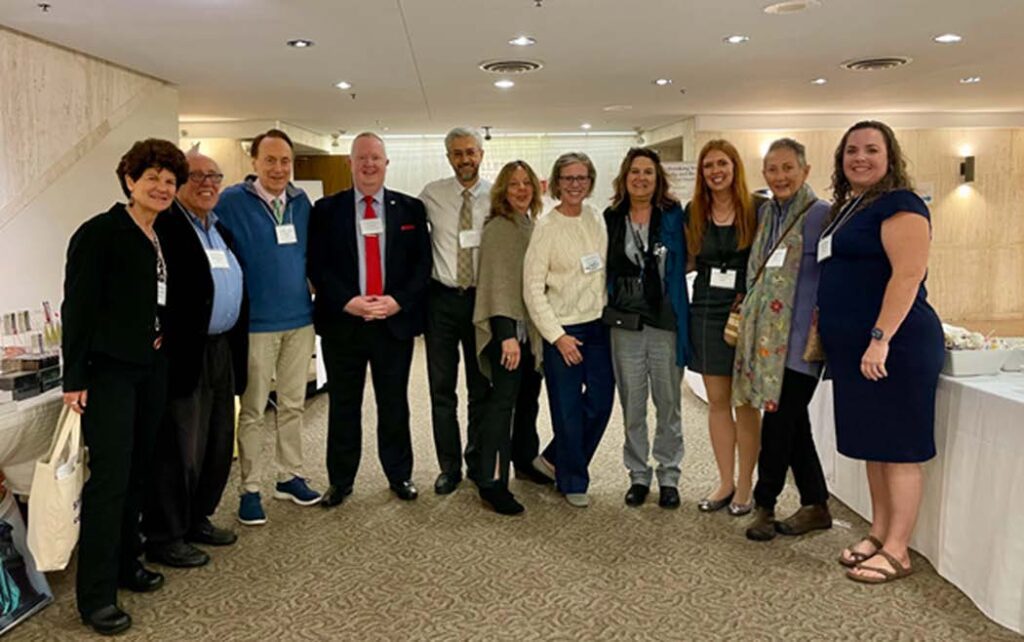
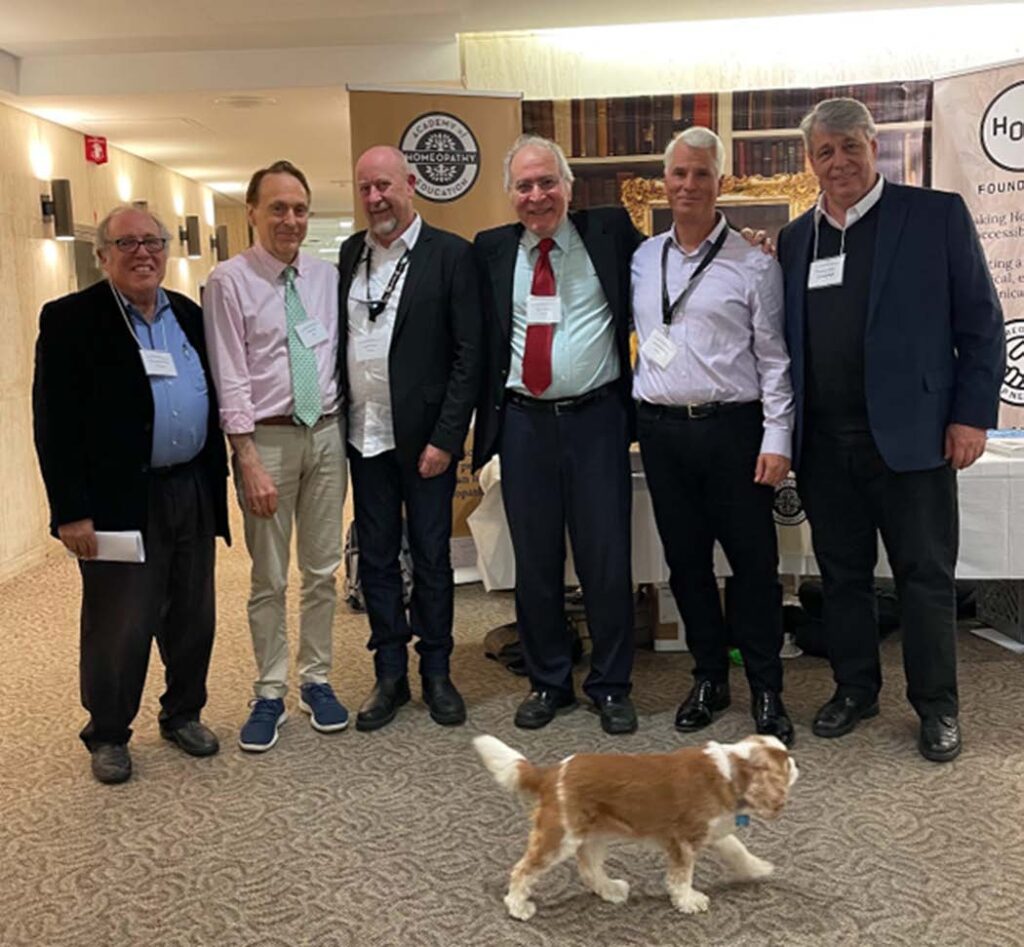
The credit for organizing this extraordinary event goes to Peter Gold, a long-time student of André Saine, activist for homeopathy, and honorary AIH member, who persuaded UConn to host it, arranged for the AIH, the UK Faculty of Homeopathy, and GIRI to cosponsor it, and micromanaged every detail connected with it. He had much capable assistance from his wife, Mary Lou Sullivan, a talented TV producer; AIH Board member Lisa Amerine, N.D., who operated the PowerPoint displays and internet connections onscreen; and AIH member Molly Punzo, M.D., who answered every call for help, wherever, whenever, and however it was needed. His contacts with the co-sponsoring organizations included, first of all, three Brazilian researchers from GIRI—Prof. Carla Holandino of the Federal University of Rio de Janeiro, their President; Prof. Leoni Bonamin of the Universidade Paulista, the Editor of their Journal; and Adalberto von Ancken, their Copy Editor. The UK Faculty of Homeopathy sent their President, Gary Smyth, M.D.; and the AIH liaison was Alex Bekker, M.D., our current President. Mary Guerrera, M.D., of the Family Medicine Department, represented UConn Health.
The conference began on Friday afternoon with a talk on homeopathy and global health by Dr. Gary Smyth, who also teaches homeopathy and integrative medicine at Queen’s University in Belfast, Northern Ireland. He pointed out that homeopathy is used by roughly 600 million people in 80 countries, making it one of the most popular systems of medicine in the world. To heal our ruling medical system, crippled with polypharmacy, polymorbidity, aging populations, and costs spiraling out of control, he cited many studies showing clear benefits of incorporating homeopathy into health care on a global scale. A grand vision encompassing plant, animal, and human health must include the proven fact that homeopathy is both sustainable and environmentally friendly, with a low carbon footprint.
The next speaker was Flavio Dantas, M.D., former Dean, Chair of Clinical Medicine, and Professor of Medicine at the Federal University of Uberlandia in Brazil, now retired, who philosophized about homeopathic research as an art form, with its challenge of balancing homeopathy’s unique focus on individual patients with the science of large statistical generalizations about what they have in common. Despite his thick elocution and throaty English pronunciation, the worth and dignity of his mission were palpable throughout.
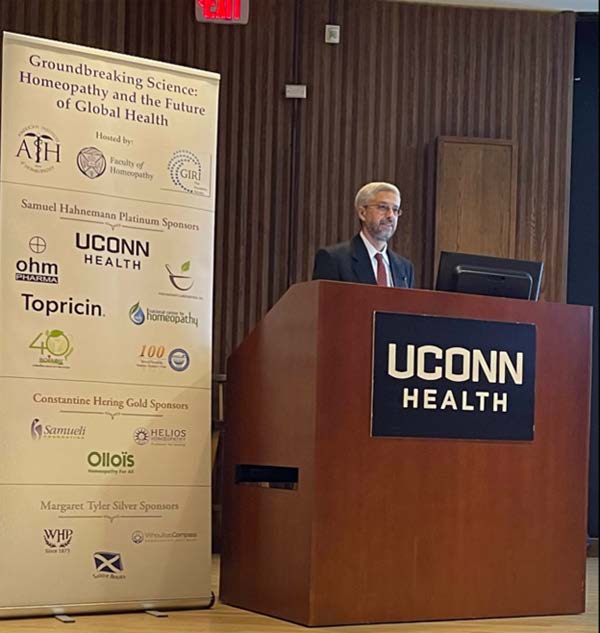
The final presentation before the break was by Alexander Tournier, Ph.D., a theoretical physicist trained at Imperial College, London, and Cambridge University, currently a Research Associate at the University of Bern in Switzerland, and a founding Director of the UK Homeopathy Research Institute, following many years of cancer research focusing on the interface between water and biological substances. Given the lack of established guidelines for basic research on ultradilute homeopathic potencies, he seemed ideally qualified to provide some; and I’d be willing to bet, notwithstanding my own thorough ignorance of the subject, that the ones he comes up with will win general acceptance. But most of all, I’m thrilled that such people are alive and walking the earth, working for us and the planet as a whole.
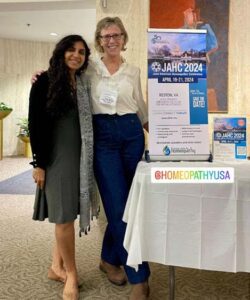
Three more presentations took up the rest of the afternoon. Entitled “Strategies for Homeopathic Research,” the first was by Raj K. Manchanda, M.D., a clinician, educator, and administrator, currently a Secretary of the Liga, or LMHI, Chairman of the Indian government’s Subcommittee on Homeopathy, and lead investigator on numerous clinical trials, basic science studies, provings, and meta-analyses. Noting the consistent benefit of homeopathic treatment reported by clinicians, he attributed the many published studies showing no measurable benefit to their reliance on allopathic models, notably RCTs, and instead proposed a mixed approach combining basic and clinical research models of our own, both to establish that high potencies do indeed work, and to explain how they work on the biochemical and subatomic level. Once again, it made me proud that universities and governments are not only taking homeopathy seriously, but hiring well-trained and respected scientists to figure out how it works and how to make practical use of it.
The second speaker was Leoni Bonamin, D.V.M., Ph.D., an officer of GIRI and Professor of Veterinary Pathology in Brazil, who lectured about the possibility of mitigating environmental damage from water polluted with various toxins, such as glyphosate, mercuric chloride, and saxitoxin from cyanobacteria in toxic algal blooms, using isopathic preparations of the toxins themselves, and of various Artemisia species. Several isodes so employed by her group did indeed show a retardant and “bioresilient” effect. Fluorescent or “solvatochromic” dyes that change color according to the pH of the solution were also found to be useful in monitoring these changes.
For me the highlight of the day was the final presentation, a masterful summary of the human microbiome by Ron Whitmont, M.D., ABIHM, Professor at New York Medical College. Over and above the intestinal flora, the discovery of bacterial and viral life throughout the body, in all of our cells, tissues, and organs, even the brain, has implicated our resident microbes in every aspect of human health and functioning, including our growing burden of illness and disease, and thus inevitably the “vital force” that presides over it all, lest we forget. He cited study after study cataloguing its disruption by the action of environmental toxins, pharmaceutical drugs and vaccines, and their basic role in the development of chronic autoimmune diseases as well.
Saturday morning began with a presentation on homeopathy in aquaculture by Prof. Antonio López-Carvallo, Ph.D., of the Center for Biological Investigation and the National Research System of Mexico, focused on promoting the immune response of marine organisms with HDBCs, or “highly diluted bioactive compounds;” i.e., homeopathics. A new technique for analyzing RNA sequences has proved useful in studying epigenetics, or gene expression, at the molecular level. He found that various HDBCs of silica, phosphoric acid, and nosodes of bacterial lysates had a stimulating effect on scallops’ ability to recognize pathogens and other foreign substances without remaining behind in the tissues, or unleashing the disruptive effect of a generalized immune response. Once again, the practical, ecological implications were farreaching. The next speaker was Paolo Bellavite, M.D., Prof. of Pathology at Verona Medical School, whose special field of investigation is the hematological action of drugs and homeopathics on white blood cells, platelets, inflammation, and the blood in general. Like the previous one, his talk was focused on epigenetics, and his observations regarding the effects of potentized Gelsemium sempervirens, Arnica montana, and Drosera rotundifolia on in vitro cell cultures. His English was quite good, but what especially impressed and inspired me, both because and in spite of my inability to follow the intricacies of his methodology, was the earnestness and dignity of his commitment to homeopathy as science, as well as its stimulus to the art of medicine.
Next was a round table on agrohomeopathy, chaired by Alex Tournier, Ph.D., with Leonard Faedo, Ph.D., an agronomist at the Federal University of Paranà, Brazil, and Coventry University in the UK; Fateme Mirzajani, Ph.D., Prof. of Phytochemistry and Nanotechnology at Shahid Beheshti University in Iran; Prof. Leoni Bonamin of Brazil, cited above; and Prof. Sydney Everhart of UConn Health. Among the issues discussed were the need for new technologies to prevent and repair the damage to plants and the ecosystem caused by pesticides; using homeopathy to improve the yield and nutritive value of various crops; and the potential of homeopathics for promoting bioresilience in plants threatened by climate change.
Prof. Everhart stressed the prevalence of fungal pathogens in agriculture and the need for alternatives to chemical fungicides, not least because crops become resistant to them so rapidly. Dr. Faedo reported on double-blind studies that showed enhanced growth of strawberries from applying fortnightly doses of common mineral remedies in the 12CH potency, using not only water, but also water itself in the 12CH, as controls: Sulphur, Phosphorus, and Kali were particularly effective. Prof. Mirzajani obtained promising results with ultradilute remedies promoting plant growth, increasing crop yields, and improving bioresilience without herbicides or pesticides.
Another roundtable after the break focused on Nanoparticles and the Nanostructure of Homeopathic Potencies. Chaired by Dr. Smyth, it also featured Iris Bell, M.D., Ph.D., a homeopathic physician and researcher in California and Arizona who has taught at Harvard, UCSF, and the University of Arizona; Jayesh Bellare, Ph.D., Prof. of Chemical and Bioengineering at the Indian Institute of Technology in Mumbai (the MIT of India); Steven Cartwright, Ph.D., a molecular biologist who heads the Cherwell Laboratory at Oxford and conducts basic research on homeopathic potencies; Prof. Igor Jerman, Ph.D., a biologist who heads the BION Institute in Slovenia and studies the electromagnetic nature of various life forms; and Michel van Wassenhoven, M.D., former Secretary of Research for the European Committee for Homeopathy, or ECH, and the Homeopathic Liga, or LMHI.
I was unable to attend the session, but according to the abstract, its starting point was a broad consensus that homeopathic preparations function as active biochemical agents, while also exhibiting nanostructural properties. The discussion focused on what role, if any, these nanostructures might play in their actions. Iris Bell’s acclaimed presentation hypothesized a signaling function for homeopathics, which Alex Tournier was quick to challenge; and the lively debate that ensued was friendly and constructive, ending with a general sense that, although the basic question remained unanswered, the audience was blessed with a little display of how scientific progress gets hammered out in real time.
I must also apologize for not taking notes during the afternoon session, since abstracts were not provided for it. It began with brief 15-minute presentations on basic science and physicochemical research, which were followed by a segment entitled “One Health,” featuring talks on environmental health, specifically zoonoses—infections passed from animals to humans—and biome preservation. For me the high point of the afternoon and indeed of the whole conference was a brief presentation by two Brazilian veterinarians who conceived the wildly improbable idea of using homeopathic potencies to attempt to restore the habitat of the Amazon rain forest, without even mentioning that thugs of the dictator Bolsonaro had been setting fire to huge swathes of it to make room for farming and mining. Anyone paying attention would have to have been as astounded as I was by their discovery that spraying aqueous solutions of homeopathic substances into rivers and lakes had actually succeeded in helping to regenerate the surrounding vegetation and animal life more rapidly, more abundantly, and over a wider area than would have been possible otherwise. Thus, quietly and unpretentiously, they offered a precious glimpse of how our beloved science might actually help save our planet; yet, I’m ashamed to say, I can’t even remember their names or the remedies they used.
Alastair Gray, Ph.D., M.Sc., founder and Research Director of the Academy of Homeopathic Education, or AHE, and Denise Straiges, M.A., C.C.H., R.S.Hom., its President and Clinical Director, gave the final presentation of the day on clinical research, summarizing their work of educating and training homeopathic practitioners at their school in Philadelphia, and of compiling an extensive clinical database for use in future research.
The Sunday morning session concluded the conference. The opening talk was by Rachel Roberts, R.S.Hom., F.S.Hom., veteran prescriber and honorary Fellow of the UK Faculty of Homeopathy, currently a Research Consultant at the Homeopathic Research Institute, or HRI. She provided a splendid, balanced overview of homeopathic clinical research, including its strengths and weaknesses, spanning both individualized and clinical homeopathy, and ranging from observational studies to RCTs, reviews, and meta-analyses. Her summary likewise bore witness to a broader acceptance of homeopathy in the scientific community yet stressing the need for still more research to facilitate its becoming an integral part of the health care system.
The next speaker was Jennifer Jacobs, M.D., M.P.H., homeopathic family physician, former President of the AIH, and Professor of Epidemiology at the University of Washington School of Public Health and Community Medicine. With all of her trademark clarity and thoroughness, she documented homeopathy’s success in protecting the microbiome by lessening the use of antibiotics in animals and humans and minimizing the emergence of bacterial strains resistant to them.
The final presentation was a roundtable on homeopathy and global health, which was chaired by Lisa Amerine, N.D., D.HANP, AIH Board Member, former President of HANP, and National Vice President of LMHI for the US, and also included Rachel Roberts, Leoni Bonamin, and Alex Tournier. Mainly they summarized and reflected on the overall sense of the conference that homeopathy, in addition to its original mission of healing the sick one by one, offers a new bioenergetic science that is still in its infancy, but already shows considerable promise for helping to heal the earth at a time of massive existential threats and challenges to the survival
of the planet and all life forms inhabiting it.
I think I can speak for many of the attendees by saying that the event succeeded far beyond our expectations in surveying the breadth and depth of basic and clinical research in homeopathy and its promise in helping to achieve a more integrated medical and health care system, and in addressing the urgent, existential challenges to global health and planetary survival as well.

About the author: Richard Moskowitz, MD, retired, practiced classical homeopathy in Watertown, Massachusetts (Boston area). He previously served as President of the NCH and taught at their Summer School. He is the author of the books “Homeopathic Medicines for Pregnancy and Childbirth”, “Resonance: The Homeopathic Point of View,” “Plain Doctoring: Selected Writings, 1983-2013,” and “More Doctoring: Selected Writings, Volume 2, 1977-2014.”
About the AJHM
The American Journal of Homeopathic Medicine (AJHM) is a peer-reviewed scientific journal, specifically intended to meet the needs of physicians involved in the specialty of homeopathy. The editor invites original manuscripts, feature articles, research reports, 'Homeopathic Grand Rounds' cases studies, abbreviated case reports for 'Clinical Snapshots,' seminar reports, and position papers that focus on homeopathy, as well as book reviews and letters to the editor. Click below to subscribe to the Journal.
Latest Issue of the AJHM

AJHM – Winter 2023
Volume 116 Number 4
Table of Contents
- Editorial: In this Issue
- Homeopathic PuZZle?
- A Case of Erectile Dysfunction and Anejaculation in a Diabetic Patient
- Iron and Its Salts: Materia Medica and Illustration
- Suppression in the Organon
- An Appreciation of Jacques Jouanny’s Life and a Review of His Opus “The Essentials of Homeopathic Therapeutics”


